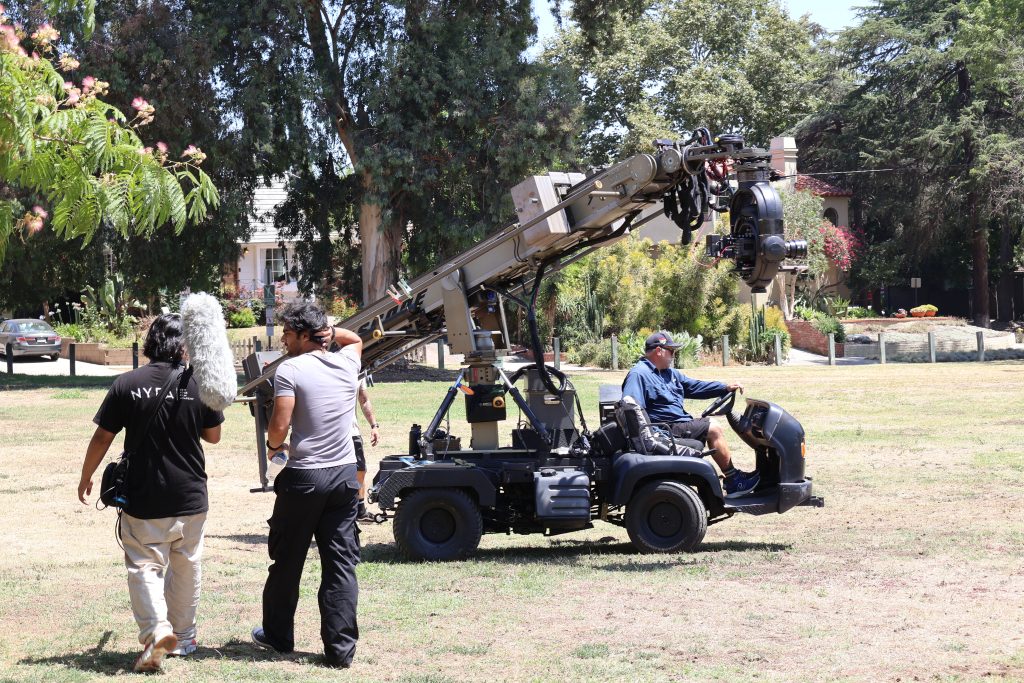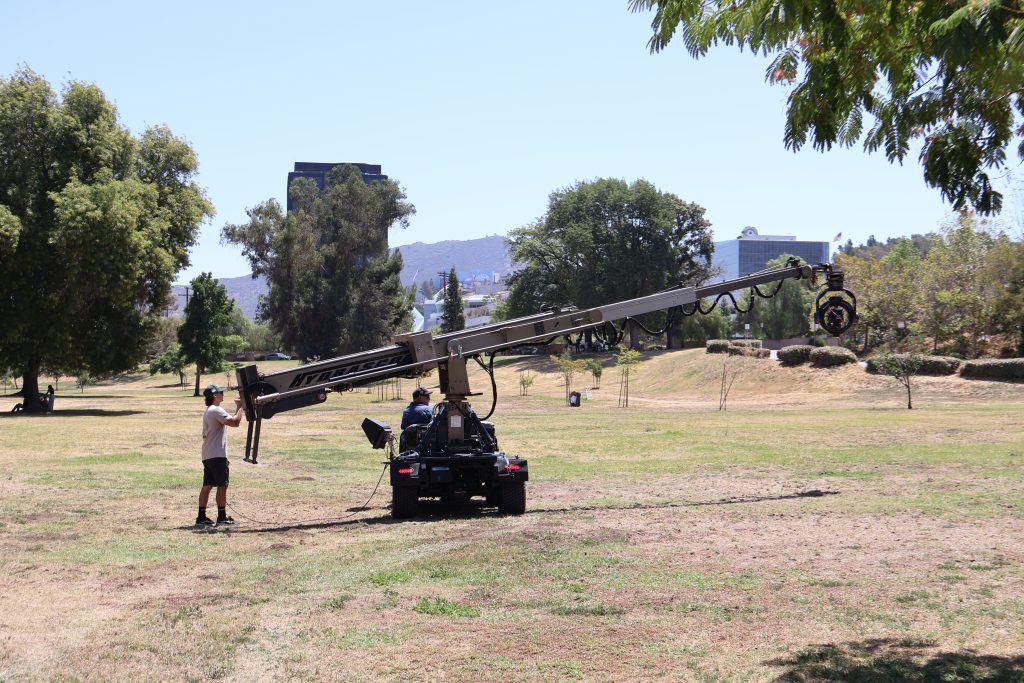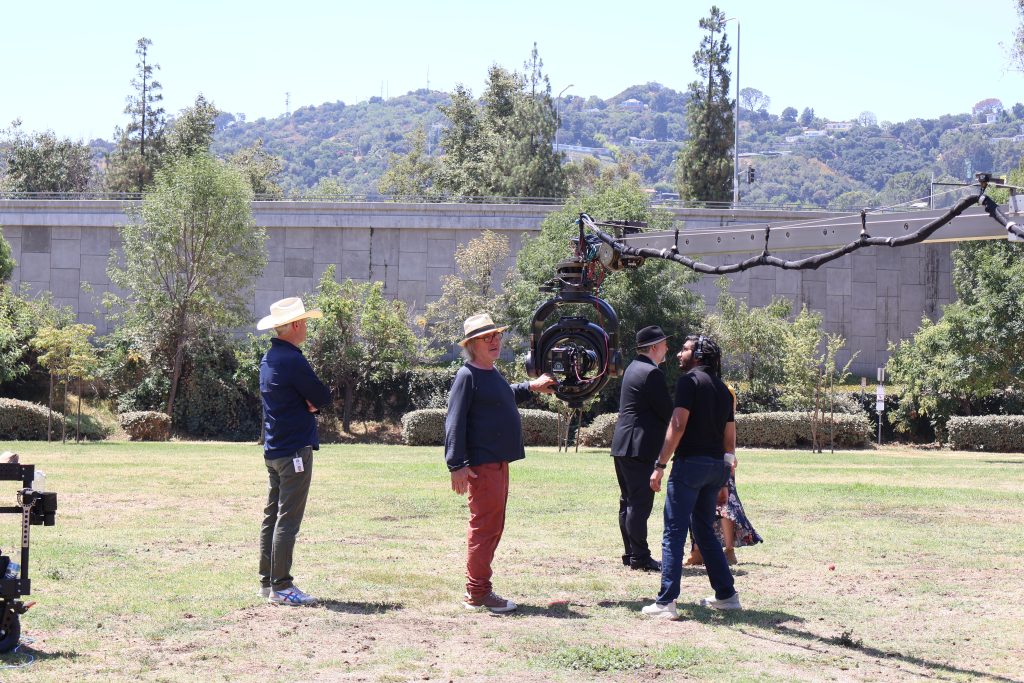This July, NYFA’s Cinematography department held a hands-on Crane Workshop for MFA Cinematography students. In this immersive workshop, students worked directly with this essential filmmaking tool, a 32-foot telescoping crane from Chapman-Leonard. Led by Cinematographer Jacek Laskus, ASC, PSC, the workshop enabled students to learn directly from a leading industry expert. The experience was invaluable for students learning the mechanics and creative possibilities of using sophisticated film equipment.

“This is a very important workshop for the MFA Cinematography students, as they have a chance to learn to use a remote head and operate the camera using the wheels. Building this skill opens up additional opportunities for them to work as a camera operator on bigger, more complex shoots, either with a remote head or a traditional geared head,” said Mike Williamson, Associate Chair of Cinematography at NYFA’s Los Angeles campus. “As cinematographers, learning to use a large crane arm is also going to unlock a huge range of possibilities for camera movement.”
Behind The Scenes in an Immersive Crane Workshop at NYFA Los Angeles
The Crane Workshop has long been a highlight of the MFA Cinematography third semester. Upon joining the program in 2015, Department Chair Anthony B. Richmond ASC, BSC redesigned this course to incorporate several of the bigger, more complex tools that students will find on major productions.

This course has become a cornerstone of the program, giving the MFA Cinematography students a unique experience to prepare them for the professional world. Through this immersion, students can understand the impact of camera movements on storytelling.
In this workshop led by Laskus, students were introduced to using a crane to tell compelling visual stories.
“Their instructor Jacek Laskus ASC, PSC has been guiding the students and helping them design their shots, and they’ve been working to execute their ideas with a high level of precision,” described Williamson. “The workshop runs all week, so each student has also had experience with the different crew positions needed to execute a crane shot. We’re grateful to our friends at Chapman-Leonard and Geo Film Group for their support in getting this gear into the students’ hands.”
The Importance of Cranes in Filmmaking and Cinematography
In filmmaking and cinematography, cranes are used to achieve a variety of dynamic and visually compelling shots. Cranes allow filmmakers to move the camera smoothly in multiple directions, providing the ability to capture unique angles and perspectives. In the industry, cranes are often used for increasing the scope of your establishing shots. Crane shots are often used for establishing shots, and introducing the setting of a scene. They can capture large sets, massive crowds, and dramatic landscapes, providing a bird’s eye view.

Overall, NYFA’s crane workshop is designed to provide a comprehensive learning experience that combines technical training with creative exploration, preparing students for the demands of the film industry.
Cinematographer Jacek Laskus, ASC, PSC
Jacek Laskus, ASC, PSC, is a distinguished cinematographer celebrated for his extensive and influential career in film. A member of both the American Society of Cinematographers (ASC) and the Polish Society of Cinematographers (PSC), Laskus has made significant contributions as a cinematographer, camera operator, and director.
Throughout his career, Laskus has worked on a diverse array of projects, demonstrating his versatility and expertise. He was twice nominated for an ASC Award for Best Cinematography in TV Pilot/Movie of the Week and worked with directors including Robert Altman, Jonathan Demme, Donald Petrie Sr., Michael Pressman, and Michael Lindsay-Hogg. Notable works in his cinematography portfolio include Parting Glances (1986), The Guardian (2001), and The Caine Mutiny Court-Martial (1988), as well as New Jack City (1991, 2nd unit work), Love & Other Drugs (2010) and The Exorcist III (1990).
Laskus was inducted into the ASC in 2000, marking a significant milestone in his career. Recently, he expanded his creative horizons by directing Picnic and a Little Mutiny, collaborating with Jack McDonald as the director of photography. This project highlights his continued commitment to exploring new facets of filmmaking. Beyond his work on set, Laskus is known for sharing his insights and expertise through interviews and discussions about cinematography. His contributions to the field have earned him respect and recognition within the film industry, solidifying his reputation as a master of his craft.
Master the Art and Craft of Cinematography at NYFA
At NYFA, we offer a dynamic, hands-on approach to learning that immerses you in the world of film and cinematography. From day one of our MFA program in Cinematography, students dive into intensive practical training with professional equipment, including industry-standard film and digital cinema cameras, lighting, and grip packages. The program covers various aspects of filmmaking, including narrative storytelling, screenwriting, directing, editing, producing, and post-production sound design. With courses led by industry-experienced faculty, students gain real-world experience through numerous projects, helping them to continue to develop a robust portfolio and reel.
Don’t just learn about cinematography—live it. Apply to NYFA and start your journey towards becoming a cinematographer today!
